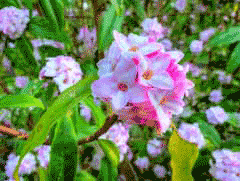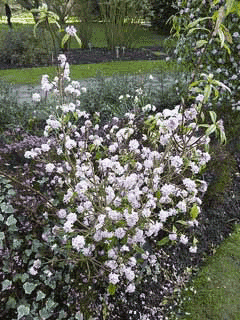 |
|
http://commons.wikimedia.org/wiki/User:Magnus_Manske |
 |
| http://commons.wikimedia.org/wiki/User:Magnus_Manske |
Translate this page:
Summary
Physical Characteristics

 Daphne bholua is an evergreen Shrub growing to 2 m (6ft) by 1.5 m (5ft).
Daphne bholua is an evergreen Shrub growing to 2 m (6ft) by 1.5 m (5ft).
See above for USDA hardiness. It is hardy to UK zone 8. It is in leaf all year, in flower from January to April. The species is hermaphrodite (has both male and female organs) and is pollinated by Bees, flies, Lepidoptera (Moths & Butterflies).
Suitable for: medium (loamy) and heavy (clay) soils and prefers well-drained soil. Suitable pH: mildly acid, neutral and basic (mildly alkaline) soils. It can grow in full shade (deep woodland) semi-shade (light woodland) or no shade. It prefers dry or moist soil. It can tolerate atmospheric pollution.
UK Hardiness Map
US Hardiness Map
Synonyms
D. cannabina. pro parte. D. papyrifera.
Plant Habitats
Woodland Garden Dappled Shade; Shady Edge;
Edible Uses
References More on Edible Uses
Medicinal Uses
Plants For A Future can not take any responsibility for any adverse effects from the use of plants. Always seek advice from a professional before using a plant medicinally.
Anthelmintic Febrifuge
The juice of the roots, combined with molasses, is used in the treatment of fevers and intestinal problems[272]. A decoction of the bark is used to treat fevers[272]. The powdered seeds are anthelmintic[272].
References More on Medicinal Uses
The Bookshop: Edible Plant Books
Our Latest books on Perennial Plants For Food Forests and Permaculture Gardens in paperback or digital formats.

Edible Tropical Plants
Food Forest Plants for Hotter Conditions: 250+ Plants For Tropical Food Forests & Permaculture Gardens.
More

Edible Temperate Plants
Plants for Your Food Forest: 500 Plants for Temperate Food Forests & Permaculture Gardens.
More

More Books
PFAF have eight books available in paperback and digital formats. Browse the shop for more information.
Shop Now
Other Uses
Fibre Paper
A very good quality paper is made from the inner bark[11, 46, 51, 61, 272]. It is one of the principle sources of hand made paper in Nepal[272]. The fibre in the inner bark can be used to make rope[146, 272].
Special Uses
Scented Plants
References More on Other Uses
Cultivation details
Prefers a cool lime-free well-drained sandy loam and a sunny position[1, 11]. Succeeds in neutral soils[11] and tolerates partial shade[200]. Plants also succeed in quite deep shade[219]. At least some forms, especially the sub-species D. bholua glacialis.(see below) tolerate alkaline soils[184]. Flowers well when grown in dry shade[184]. Likes plenty of moisture in the growing season[11]. Grows well in London, tolerating atmospheric pollution[184]. Said to be hardy to about -5°c[200], plants succeed outdoors in southern England, but are defoliated in severe winters[11]. Plants at higher altitudes in its native range are often deciduous whilst plants from lower altitudes are evergreen but less hardy[166]. A very variable and very ornamental species[1, 200], the cultivars 'Ghurka' (deciduous) and 'Jacqueline Postill' (evergreen) are more hardy than the type[182, 200]. One report says that the cultivar 'Ghurka' is part of the deciduous sub-species D. bholua glacialis. (W.W.Smith.&Cave.)Burtt. and that it can tolerate temperatures down to about -10°c[184]. The flowers are fragrant[272]. Because it flowers in the winter, this species seldom produces much seed in Britain unless it is hand-pollinated[214]. Plants often sucker and form clumps in the wild[214]. Plants are resentful of root disturbance and should be planted into their permanent positions as soon as possible[188].
References Carbon Farming Information and Carbon Sequestration Information
Temperature Converter
Type a value in the Celsius field to convert the value to Fahrenheit:
Fahrenheit:
The PFAF Bookshop
Plants For A Future have a number of books available in paperback and digital form. Book titles include Edible Plants, Edible Perennials, Edible Trees,Edible Shrubs, Woodland Gardening, and Temperate Food Forest Plants. Our new book is Food Forest Plants For Hotter Conditions (Tropical and Sub-Tropical).
Shop Now
Plant Propagation
Seed - best sown in a greenhouse as soon as it is ripe with the pot sealed in a polythene bag to hold in the moisture. Remove this bag as soon as germination takes place[164]. The seed usually germinates better if it is harvested 'green' (when it has fully developed but before it dries on the plant) and sown immediately. Germination should normally take place by spring, though it sometimes takes a further year. Stored seed is more problematic. It should be warm stratified for 8 - 12 weeks at 20°c followed by 12 - 14 weeks at 3°c. Germination may still take another 12 months or more at 15°c[164]. Prick out the seedlings into individual pots as soon as they are large enough to handle. Grow the plants on in the greenhouse for their first winter and then plant out in spring after the last expected frosts. Cuttings of half-ripe wood with a heel, June/July in a frame[214]. Division of suckers[214]. Layering.
Other Names
If available other names are mentioned here
Native Range
TEMPERATE ASIA: China (Sichuan Sheng, Xizang Zizhiqu, Yunnan Sheng (northwest)) TROPICAL ASIA: Bangladesh, Bhutan, India (Sikkim), Nepal, Myanmar
Weed Potential
Right plant wrong place. We are currently updating this section.
Please note that a plant may be invasive in one area but may not in your area so it's worth checking.
Conservation Status
IUCN Red List of Threatened Plants Status :

Growth: S = slow M = medium F = fast. Soil: L = light (sandy) M = medium H = heavy (clay). pH: A = acid N = neutral B = basic (alkaline). Shade: F = full shade S = semi-shade N = no shade. Moisture: D = dry M = Moist We = wet Wa = water.
Now available:
Food Forest Plants for Mediterranean Conditions
350+ Perennial Plants For Mediterranean and Drier Food Forests and Permaculture Gardens.
[Paperback and eBook]
This is the third in Plants For A Future's series of plant guides for food forests tailored to
specific climate zones. Following volumes on temperate and tropical ecosystems, this book focuses
on species suited to Mediterranean conditions—regions with hot, dry summers and cool, wet winters,
often facing the added challenge of climate change.
Read More
Expert comment
Author
Buch.-Ham. ex D.Don.
Botanical References
1151200
Links / References
For a list of references used on this page please go here
Readers comment
© 2010, Plants For A Future. Plants For A Future is a charitable company limited by guarantee, registered in England and Wales. Charity No. 1057719, Company No. 3204567.